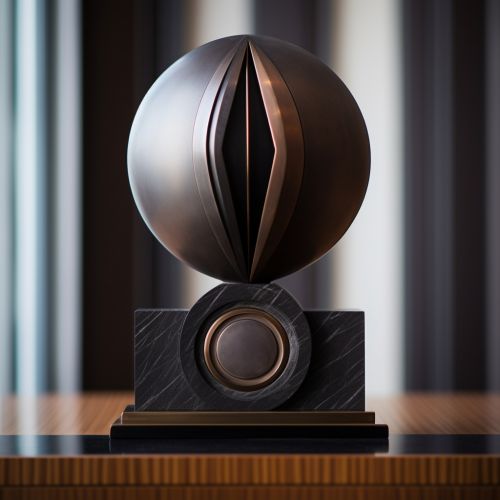Proportion (design)
Definition and Overview
Proportion in design refers to the balance and harmony achieved by the appropriate scale and size of components within a work of art or design. It is one of the fundamental principles of design, alongside balance, contrast, emphasis, movement, pattern, rhythm, and unity/variety. Proportion can be observed in all aspects of design, including architecture, graphic design, industrial design, and fashion design.
Understanding Proportion in Design
Proportion is a principle that designers use to ensure that the parts of a design fit together well. It involves the relationship of size between objects or parts of objects. This can include the size of one element in relation to another within a design, or the size of an object in relation to the space in which it is placed. Proportion can also refer to the relationship between different parts of a whole. For example, in human body proportions, the body is typically divided into eight heads tall, with each 'head' being a specific measurement.


Importance of Proportion in Design
Proportion is a critical element in design as it significantly influences the aesthetic and functional success of a design. It can affect the balance and harmony of a design, its visual impact, and its usability. Designs with good proportion are often perceived as being balanced and harmonious, while those with poor proportion can appear awkward or unbalanced. Proportion can also influence the perceived stability and weight of a design. For example, a building with disproportionately large upper floors may appear unstable, while a product with a disproportionately small base may appear lightweight.
Proportion in Different Design Disciplines
Proportion is a principle that applies across different design disciplines, each with its unique considerations and applications.
Architecture
In architecture, proportion is a key factor in the aesthetic and functional success of a building. Architects use proportion to ensure that the various parts of a building relate harmoniously to each other and to the whole. This includes the size and scale of different architectural elements, such as doors, windows, columns, and roofs, as well as the overall size and shape of the building itself. Architectural proportion can also refer to the relationship between a building and its surrounding environment, including other buildings, landscapes, and human scale.
Graphic Design
In graphic design, proportion is used to create balance and harmony among different design elements, such as text, images, and white space. It can also influence the visual hierarchy of a design, guiding the viewer's eye to the most important elements. Graphic designers often use grids and ratios, such as the golden ratio, to achieve good proportion in their designs.
Industrial Design
In industrial design, proportion is crucial in determining the usability and aesthetic appeal of a product. It can influence the comfort and ease of use of a product, as well as its visual impact. Industrial designers often use human factors and ergonomics, as well as aesthetic principles, to determine the appropriate proportions for a product.
Fashion Design
In fashion design, proportion refers to the relationship between different parts of a garment, such as the length of a sleeve in relation to the body of a shirt, or the width of a pant leg in relation to its length. It can also refer to the relationship between a garment and the body wearing it. Fashion designers use proportion to create garments that are flattering and comfortable, as well as visually appealing.
Historical and Cultural Considerations
Proportion has been a significant consideration in design throughout history and across cultures. Different cultures and periods have had different standards and ideals of proportion, which have influenced their art and design.
For example, the ancient Greeks developed the concept of the golden ratio, a mathematical ratio that they believed created aesthetically pleasing proportions. This ratio, also known as Phi, has been used in various forms of design, including architecture, art, and product design.
In contrast, the Japanese concept of Ma or negative space, reflects a different approach to proportion. In this context, the proportion of empty space to filled space is considered critical in achieving a balanced and harmonious design.
Methods and Tools for Achieving Good Proportion
Designers use various methods and tools to achieve good proportion in their designs. These can include mathematical ratios, grids, and scale models.
Mathematical Ratios
Mathematical ratios, such as the golden ratio, are often used in design to achieve pleasing proportions. The golden ratio is approximately 1:1.618 and is believed to create aesthetically pleasing proportions. Other ratios, such as the root 2 ratio (1:1.414) and the silver ratio (1:1.414), are also used in design.
Grids
Grids are a common tool used in design to achieve good proportion. They provide a framework that can guide the placement and sizing of design elements, helping to create a balanced and harmonious design. Grids can be simple, with evenly spaced rows and columns, or more complex, with varying row and column widths and heights.
Scale Models
Scale models are often used in disciplines such as architecture and industrial design to test the proportions of a design before it is built. By creating a small-scale version of a design, designers can see how the various parts of a design relate to each other and to the whole, and make adjustments as needed.
Challenges in Achieving Good Proportion
Achieving good proportion in design can be a complex process, with several challenges. These can include the need to balance aesthetic considerations with functional requirements, the influence of cultural and personal preferences, and the limitations of materials and manufacturing processes.
Conclusion
Proportion is a fundamental principle of design that can significantly influence the aesthetic and functional success of a design. By understanding and effectively using proportion, designers can create works that are balanced, harmonious, and pleasing to the eye.
